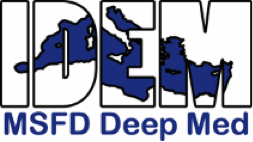Project budget: € 960.000
Partners: 9
Start date: 1 April 2017
Duration: 24 months
The project IDEM (Implementation of the MSFD to the DEep Mediterranean Sea) aims to support the next phase of MSFD implementation, in particular to achieve, by the end of the project, a regionally coherent, coordinated and consistent initial environmental assessment and determination of GES, as well as the definition of sets of environmental targets for the Mediterranean deep Sea (below 200 m of depth). Beside this, IDEM aims at understanding, quantifying and mapping drivers, anthropogenic pressures and impacts, current knowledge and spatial coverage of data regarding the MSDF indicators in the Mediterranean deep sea. These represent crucial steps towards developing a comprehensive set of environmental targets and associated indicators/criteria that can be used to extend the concept of Good Environmental Status (GES) to the deep sea.
Objective of IDEM will be to review and update the current determinations of GES, environmental targets and criteria/indicators assessed so far for Mediterranean Sea coastal areas to be adapted to the Mediterranean deep-sea basin. This will be done through literature/existing data review and scientific surveys already scheduled, which will be conducted in ongoing national or international programs during the lifespan of IDEM. Furthermore, an integrative analysis of all indicators will be performed in order to establish key-areas for monitoring.
Overall, IDEM will provide also crucial information for the conservation and management of the deep Mediterranean sea, contributing to the action and initiatives for the identification of Special Areas of Conservation and the design of Marine Protected Areas (MPA) networks (e.g. Joint Management Action of the European Community with the United Nations Environment Programme/Mediterranean Action Plan). Presently, the only off-shore Mediterranean MPAs are located in France and Spain: the National Park of Calanques includes an off-shore area, for the protection of cold-water corals (CWCs) of Le Cassaidagne canyon and the MPA of the Gulf of Lyon, which encompasses seven canyons, two of them characterised by the occurrence of the deep corals Lophelia pertusa and Madrepora oculata. There are also off-shore areas in which trawling activities are banned or restricted. The banned areas include the Lophelia reef off Capo Santa Maria di Leuca (1673 km2, GSA 19, Italy), the Nile Delta Area - cold hydrocarbon seeps (6043 km2, GSA 26, Egypt) and the Eratosthenes Seamount deep-sea benthic habitats colonised by scleractinian corals and sponges (14792 km2 GSA 25, Cyprus), all of which established by Rec. GFCM/30/2006/3; the Strait of Sicily - nursery areas of European hake and deep-water rose shrimp (GSAs 12-14, between Italy and Malta) established by Rec. GFCM/40/2016/4. The restricted area to only authorized vessels includes the Eastern part of the Gulf of Lyon, identified as important aggregations of spawners (European hake, monk fish, lobsters) area (3742 km2 GSA 07, France) established by Rec. GFCM/33/2009/1.
The structure of IDEM project
The following main activities are foreseen within IDEM:
- a review of literature (including “grey” literature) relevant for MSDF implementation in the Mediterranean deep Sea;
- collection of existent and newly acquired databases in order to create GIS maps of the spatial extent of the descriptors/criteria/indicators as well as human pressures/impacts on the Mediterranean deep-sea ecosystems;
- adaptation of the MSFD descriptors/criteria/indicators to the Mediterranean deep Sea;
- identification of threshold/baseline values for GES in the Mediterranean deep sea;
- identification of the gaps in knowledge concerning the 11 descriptors in the Mediterranean deep Sea, for each sub-basin;
- identification of guidelines for monitoring deep-sea environments and for designation of areas to be potentially protected;
- stakeholders engagement and dissemination of IDEM results.
More specifically, to achieve the IDEM’s aims, the above-mentioned activities will be organized in 4 different operational Actions and related Tasks.

